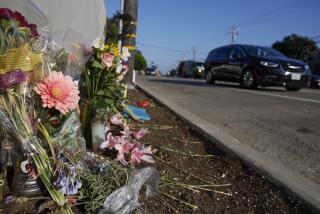A road warrior seeks to cross out horrors of auto accidents : A coroner marks site of traffic deaths. While highway officials tell her she has no authority to paint on roads, she sees practice as extension of a safety campaign.
- Share via
AIKEN, S.C. — From lonely country roads to busy highways amid the rolling meadows and thick forests of this southwestern South Carolina area, white crosses mark the spots where people died in traffic accidents.
They are the handiwork of Aiken County Coroner Sue Townsend, who hauls a plywood stencil in the back of her white station wagon so that each time she finishes collecting information about a fatal crash, she can paint a cross on the roadway. It is her way of telling residents that traffic accidents frequently claim the lives of their neighbors.
But now, the South Carolina Department of Highways and Public Transportation wants her to stop, telling her she has no authority to paint on roads. Highway engineers say such markings endanger motorists who may be confused by them.
They also worry that if Townsend gets away with it, every civic club, school or rebel with a cause will unleash their artistic abilities on the state’s roadways.
“The fact is, nobody is authorized to put anything on the roadways,” said Don Turner, the highway department’s senior traffic engineer.
Townsend estimates she has painted 100 crosses since she stenciled the first one in April, 1989, on a sharp curve where a teen-age girl died after her brother lost control of his car, slamming into a tree.
“It was one of those that’s very, very difficult to deal with,” said Townsend, coroner here for the past nine years and the only female coroner in the state. “That’s why I said, I’m going to try this. South Carolina’s got such a bad record. Something had to be done.”
Up until three years ago when the state launched an extensive public awareness campaign, drivers seemed almost as lackadaisical about driving as folks did in 1930 when licenses were first required. Then, getting a license was no different from buying a sack of seed. South Carolinians simply visited a nearby store and paid 50 cents. A whole family, including children 12 to 21, could get licenses for $1. The highway department didn’t start testing drivers until 1941.
“We’ve been a lethargic state for so long. No one took driving seriously,” said Townsend, noting that many insurance companies have fled the state due to residents’ poor driving.
Only in the last three years has South Carolina begun to shake off its longstanding reputation as the state with the most highway deaths per highway miles. A flurry of laws and the much-praised public safety campaign generally get credit for a gradually improving safety record.
South Carolina, like all states, requires that children younger than 4 be strapped in car seats, and, like 37 other states, including California, that passengers wear seat belts. In the 1980s, the state also forbade open alcoholic containers in cars and enacted stiffer penalties for drunken driving.
While various groups praise such efforts, they also point out that South Carolina has a way to go. The highway department has tried for nine years to give patrolmen the right to revoke the license of anyone testing 0.10% or higher on a Breathalyzer test. And, the state does not require driver training for teen-agers, a staple in many states for more than two decades.
The centerpiece of the state’s efforts, however, has been the public service campaign, called “Highways or Dieways? The choice is yours.” No other program in the nation has been as pervasive or as graphic, said Max Young, the highway department’s safety director.
The commercials emphasize that drivers choose to drive safely or erratically and shows what happens if they choose the latter: cars careening off bridges, running over road workers, sideswiping a father changing a tire. One commercial, which some television stations refused to air for fear it would disturb viewers, shows a former Miss South Carolina made up to look as though her face was mangled in a horrible collision.
“We thought the more graphic, the gorier you can make it, the better,” Young said. A few criticized the department for going too far. But the campaign has won several national awards and other states, including Arizona, have adopted it.
Townsend said her paintings only complement that campaign and extend the nation’s longstanding practice of marking roadways to make them safer. The first markings were done by June A. Carroll, a doctor, in 1912 in Indio, Calif. She painted a center line on a treacherous section of highway, prompting the California Highway Commission and then other states to adopt the markings.
Many of Townsend’s colleagues, gathered recently for a coroners’ association meeting, sought copies of her stencil to launch similar campaigns in their counties, she said.
Townsend herself has no plans to stop.
“I told them to find a law that says I can’t do this,” she said. “They never did, and I never quit.”
More to Read
Sign up for Essential California
The most important California stories and recommendations in your inbox every morning.
You may occasionally receive promotional content from the Los Angeles Times.












